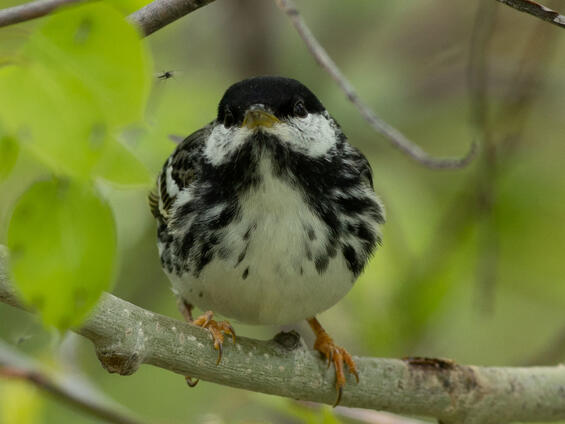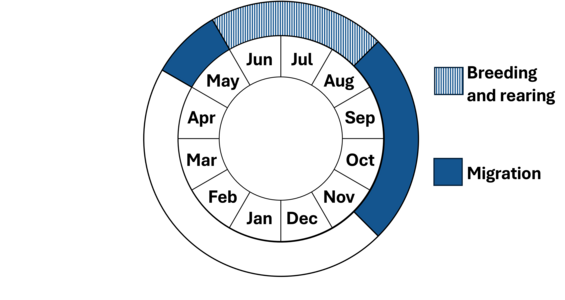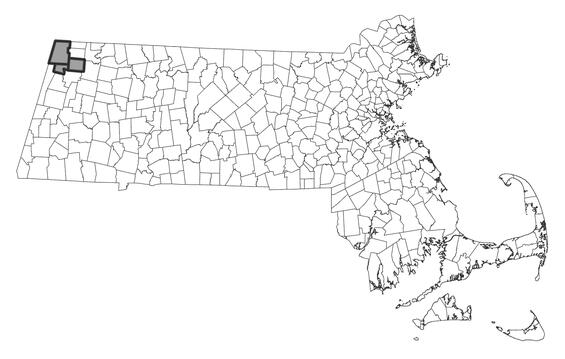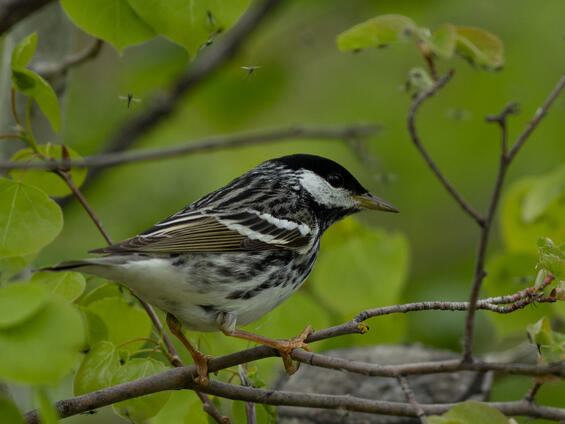- Scientific name: Setophaga striata
- Species of Greatest Conservation Need (MA State Wildlife Action Plan)
- Special concern (MA Endangered Species Act)
Description

Blackpoll warbler (Setophaga striata)
The breeding male blackpoll warbler is a striped smoky-gray with a solid-black cap, white cheeks, and a white throat. It is streaked black above, white below with black streaks running from the chin along its sides almost to its tail, has two white wing bars, and white spots on the outer two or three tail feathers. The females are less heavily streaked, without the black crown patch or white cheeks, but otherwise marked much like the male on its back, wings and tail with an olive-green to gray body color and olive-yellow sides. The female also has a pale ring around the eye and a light streak above it. Both the male and female have a brown iris, light brown legs, and yellowish-brown feet. The non-breeding male has no black cap but rather a pale olive-yellow head streaked with stray black feathers and an indistinct streak above the eye. This warbler is 12.7-14.6 cm (5.0-5.75 in) in length with a wingspan of 21.1-24.6 cm (8-9.75 in).
In its breeding plumage, the male blackpoll warbler resembles the black-and-white warbler (Mniotilta varia) in overall coloration, but is easily distinguishable by the distinct black cap. Their feeding behavior as well as their preferred habitat separate them from one another. The black-and-white warbler feeds from side to side on a tree trunk and prefers deciduous woods, while the blackpoll feeds by hopping from twig to twig among the branches preferring coniferous woods.
In its winter plumage, the male blackpoll is often confused with the bay-breasted warbler (Setophaga castanea) but lacks the chestnut-colored sides of the bay-breasted, and the blackpoll's undertail coverts are always white. The best field mark in distinguishing between these two warblers is the color of the legs, which in the blackpoll is light, approaching a yellowish color, while in the bay-breasted it is dark brown, and in some instances almost black. Both the bay-breasted warbler and the blackpoll warbler are birds of coniferous woods.
Life cycle and behavior

Figure 1. Phenology in Massachusetts. This is a simplification of the annual life cycle. Timing exhibited by individuals in a population varies, so adjacent life stages generally overlap each other at their starts and ends.
In the spring in Massachusetts, the main migration wave of blackpolls arrives late in May. They travel a distance of not less than 4000 km (2500 mi), and the extremes of the range - Alaska and Brazil are twice that distance. It is one of the very few warblers that migrate directly across the West Indies from South America to Florida. Usually, they are among the last of the wood warblers to appear, and although they arrive in high numbers, they keep mostly in leafy tree-tops where they are difficult to view with only their frequent song as evidence of their presence.
The song of the blackpoll warbler is one of the highest pitched songs of any North American passerine. It is an insect-like trill, a high, thin tree-tree-tree-tree-tree-tree given on one pitch of equal length, beginning very softly, gradually increasing in the middle, then falling softer at the end. The last notes are sometimes run rapidly together, with an almost sputtering effect. The call note is a high-pitched lisp which resembles zeet. During the fall migration, the diurnal note tsit is the most common sound heard.
Males establish territories during June and courtship and nest building ensues in a slow deliberate procedure. Eggs are not laid before the second or third week of June. The blackpoll warbler is a bird of the northern spruce-fir forests, and it is this habitat that seems to be an essential requirement for its nesting. Their nest is normally placed low in young conifers, commonly two to seven feet above ground. It rests snugly against the trunks of trees, supported by horizontal branches and well concealed by overhanging foliage. The nest is constructed of small twigs and sprays of spruce, pieces of bark, dried grasses, and weeds mixed with bits of moss, lichens, and wool, and are lined with fine rootlets, hair, and a liberal lining of white gull feathers.
Nest construction, incubation of the eggs, and brooding of the young are performed mainly by the female. Clutches typically consist of 3-5 eggs, with 4 or 5 being the norm. They may be white, light creamy buff, or sometimes a pale green ground color, with brown and umber specks scattered over the whole surface. Eggs are laid daily until the set is complete. Incubation is at least 11 days. The young open their eyes at 5 days and are fed by both parents until they fledge, 11-12 days after hatching. A single brood is raised per year.
The blackpoll warbler feeds on insects. Their diet consists of aphids, scale insects, cankerworms, sawflies and other insects that infest trees, spiders and their eggs, wasps, ants, and termites. In the fall, the blackpoll eats a few seeds and berries such as pokeberry (Phytolacca americana). They glean insects from leaves and twigs and frequently dart from the concealment of the foliage to capture some passing flying insect much like a flycatcher.
The blackpoll warbler is known as the longest distance migrant of the warbler species. In the fall, the blackpoll warbler undertakes a southern migration to South America that peaks in September and extends into October. Birds congregate along the New England coast before departing over the Atlantic Ocean on a non-stop flight to South America.
Population status
According to the Breeding Bird Survey, the blackpoll warbler has experienced an annual range-wide decline of 2.2% between 1966-2022. It is currently considered a species of Special Concern in Massachusetts due to its rarity as a breeding species. It is known to breed in only two locations in Massachusetts -the summit of Mt. Greylock and Savoy Mountain State Forest, both of which are in the Berkshires in the extreme northwestern part of the state. For some time, Mt. Greylock was believed to be the sole breeding site for the blackpolls, but in 1980 one breeding pair was recorded at the Savoy Mountain State Forest. In 1990, 22 singing males were recorded in four areas along the summit of Mt. Greylock, indicative of breeding/nesting activity (Quinlan, 1990).
Distribution and abundance
The breeding range of the blackpoll warbler is from Alaska east to northern Ontario, northern Labrador, and Newfoundland south to central Manitoba, central Ontario, central Quebec, and locally, at high elevations, to western Massachusetts. It winters in northern South America, from Colombia and Venezuela south to Peru, Chile, Brazil, and Ecuador and migrates through the West Indies.

Distribution in Massachusetts. 1999-2024. Based on records in the Natural Heritage Database.
Habitat
The blackpoll warbler is limited in Massachusetts by the lack of its preferred habitat - stunted spruce-fir forest. Near the summit of Mt. Greylock, in northern Berkshire County, breeding blackpoll warblers are found in patches of stunted balsam fir (Abies balsamea). The breeding sites are conifers of medium to small size. The occurrence of very young or stunted balsam firs, cool woods, and filtered light seem to be a prerequisite for attracting the blackpolls.
Healthy habitats are vital for supporting native wildlife and plants. Explore habitats and learn about conservation and restoration in Massachusetts.

Blackpoll warbler (Setophaga striata)
Threats
The greatest potential impact on its future as a breeding species in Massachusetts is a change in its present breeding habitat, stunted balsam fir. Any manipulation of the breeding grounds is certain to bring about a decline in the number of nesting blackpolls and possibly result in the extirpation of the species from the state. It should also be noted that studies have shown that this habitat is sensitive to the effects of acid rain. Predation by domestic cats has been identified as the largest source of mortality for wild birds in the United States with the number of estimated mortalities exceeding 2 billion annually. Cats are especially a threat to those species that nest on or near the ground.
An additional threat to the species is collisions with buildings and other structures, as approximately 1 billion birds in the United States are estimated to die annually from building collisions. A high percentage of these collisions occur during the migratory periods when birds fly long distances between their wintering and breeding grounds. Light pollution exacerbates this threat for nocturnal migrants as it can disrupt their navigational capabilities and lure them into urban areas, increasing the risk of collisions or exhaustion from circling lit structures or areas.
Conservation
The protection of any remaining nesting habitat is important for the conservation of the species as a nesting bird in Massachusetts. Protecting important wintering and stopover habitats is also important to support the full annual cycle conservation of the species.
Promote responsible pet ownership that supports wildlife and pet health by keeping cats indoors and encouraging others to follow guidelines found at fishwildlife.org.
Bird collision mortalities can be minimized by making glass more visible to birds. This includes using bird-safe glass in new construction and retrofitting existing glass (e.g., screens, window decals) to make it bird-friendly and reducing artificial lighting around buildings (e.g., Lights Out Programs, utilizing down shielding lights) that attract birds during their nocturnal migration.
References
Bent, A.C. Life Histories of North American Wood Warblers. 2 Vols. New York: Dover Publications, 1961.
DeLuca, W., R. Holberton, P. D. Hunt, and B. C. Eliason (2020). Blackpoll Warbler (Setophaga striata), version 1.0. In Birds of the World (A. F. Poole, Editor). Cornell Lab of Ornithology, Ithaca, NY, USA.
Forbush, E.H. Birds of Massachusetts and Other New England States. Vol. III: Land Birds from Sparrows to Thrushes. Norwood, MA: Norwood Press/Berwick & Smith Company, 1927.
Harrison, H.H. Wood Warblers' World. New York: Simon and Schuster, 1984.
Petersen, W.R., and R.R. Veit. Birds of Massachusetts. Lincoln, MA: Massachusetts Audubon Society, 1993.
Quinlan, C.B. "Blackpoll Breeding Sites." Breeding Bird Survey of the Northern Berkshire Highlands (1990): 53-66.
Sauer, J.R., J.E. Hines, J.E. Fallon, K.L. Pardieck, D.J. Ziolkowski, Jr., and W.A. Link. 2022. The North American Breeding Bird Survey, Results and Analysis 1966 - 2022. Version 01.30.2015 USGS Patuxent Wildlife Research Center, Laurel, MD.
Contact
| Date published: | April 23, 2025 |
|---|